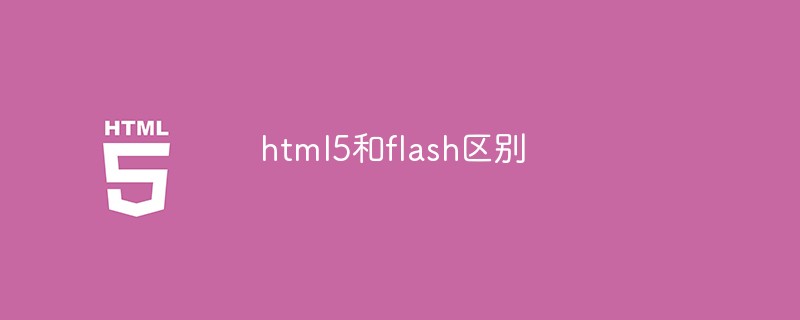What are the differences between html5 and flash
The difference between html5 and flash: 1. Different references, html5 is the specification of HTML, the core language in the Web, while flash is the standard for interactive vector graphics and Web animation; 2. Different uses, html5 can bring the Web to Enter a mature application platform, and flash can quickly design simple animations; 3. Development is different.

The operating environment of this article: Windows7 system, HTML5&&Adobe Flash CS6 version, Dell G3 computer.
1. Different references
1. html5: It is the specification of the core language HTML in the Web. The content that users see when browsing the web using any means is originally in HTML format. The browser uses some technical processing to convert it into identifiable information.
2. Flash: A standard for interactive vector graphics and Web animation launched by Macromedia and acquired by Adobe.
2. Different uses
1. HTML5: Bringing the Web into a mature application platform, on which video, audio, images, animations and interactions with devices are all carried out specification.
2. Flash: Used to create attractive applications containing rich videos, sounds, graphics and animations. Create original content in Flash or import it from other Adobe applications such as Photoshop or Illustrator to quickly design simple animations.
3. Development differences
1. HTML5: It enables programs to pass through a web browser, allowing consumers to download programs from any terminal including personal computers, laptops, smartphones or tablets. Access the same programs and cloud-based information.
2. Flash: Since the functions of HTML (an application under Standard Universal Markup Language) are very limited, it cannot meet people's expected design to achieve refreshing dynamic effects. In this case, various A scripting language emerged at the historic moment, making web design more diverse.
For more detailed HTML/CSS knowledge, please visit the HTML video tutorial column!
The above is the detailed content of What are the differences between html5 and flash. For more information, please follow other related articles on the PHP Chinese website!

Hot AI Tools

Undresser.AI Undress
AI-powered app for creating realistic nude photos

AI Clothes Remover
Online AI tool for removing clothes from photos.

Undress AI Tool
Undress images for free

Clothoff.io
AI clothes remover

AI Hentai Generator
Generate AI Hentai for free.

Hot Article

Hot Tools

Notepad++7.3.1
Easy-to-use and free code editor

SublimeText3 Chinese version
Chinese version, very easy to use

Zend Studio 13.0.1
Powerful PHP integrated development environment

Dreamweaver CS6
Visual web development tools

SublimeText3 Mac version
God-level code editing software (SublimeText3)

Hot Topics
 Table Border in HTML
Sep 04, 2024 pm 04:49 PM
Table Border in HTML
Sep 04, 2024 pm 04:49 PM
Guide to Table Border in HTML. Here we discuss multiple ways for defining table-border with examples of the Table Border in HTML.
 Nested Table in HTML
Sep 04, 2024 pm 04:49 PM
Nested Table in HTML
Sep 04, 2024 pm 04:49 PM
This is a guide to Nested Table in HTML. Here we discuss how to create a table within the table along with the respective examples.
 HTML margin-left
Sep 04, 2024 pm 04:48 PM
HTML margin-left
Sep 04, 2024 pm 04:48 PM
Guide to HTML margin-left. Here we discuss a brief overview on HTML margin-left and its Examples along with its Code Implementation.
 HTML Table Layout
Sep 04, 2024 pm 04:54 PM
HTML Table Layout
Sep 04, 2024 pm 04:54 PM
Guide to HTML Table Layout. Here we discuss the Values of HTML Table Layout along with the examples and outputs n detail.
 HTML Ordered List
Sep 04, 2024 pm 04:43 PM
HTML Ordered List
Sep 04, 2024 pm 04:43 PM
Guide to the HTML Ordered List. Here we also discuss introduction of HTML Ordered list and types along with their example respectively
 Moving Text in HTML
Sep 04, 2024 pm 04:45 PM
Moving Text in HTML
Sep 04, 2024 pm 04:45 PM
Guide to Moving Text in HTML. Here we discuss an introduction, how marquee tag work with syntax and examples to implement.
 HTML Input Placeholder
Sep 04, 2024 pm 04:54 PM
HTML Input Placeholder
Sep 04, 2024 pm 04:54 PM
Guide to HTML Input Placeholder. Here we discuss the Examples of HTML Input Placeholder along with the codes and outputs.
 HTML onclick Button
Sep 04, 2024 pm 04:49 PM
HTML onclick Button
Sep 04, 2024 pm 04:49 PM
Guide to HTML onclick Button. Here we discuss their introduction, working, examples and onclick Event in various events respectively.






